|
FAQs about Artificially Colored Live
Corals
Related Articles: Artificially Colored Corals, Dyed
Anemones, LPS Corals,
True or Stony Corals, Order
Scleractinia, Propagation for Marine
Aquarium Use, Trachyphyllia
Reproduction Event, Soft
Corals, Stony Coral
Identification,
Related FAQs: Colored/Dyed Anemones, Growing Reef Corals, Stony Coral Behavior, Coral
Compatibility,
Bizarrely dyed Heliofungia at a tradeshow...
|
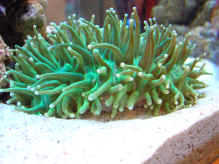
|
|
Green Finger Leather
Bruised?/Alcyoniidae Health 11/14/10
<Hello Astrid>
I know that you get tons of questions so I will try to keep this
brief. I have a 20 gallon Nano tank. The pH is a bit low 8.1 and
the alkalinity is low also 2.7 me/li <meq/liter and is not low
(7.5 dKH).>. I am using expired tests and have new ones on
order. The not expired, dip stick tests show pH between 8.0 and
8.4 and the alkalinity between 240 and 300 ppm.
<Ballpark figures with dip strips.>
I have some buffer but don't want to use it until I get test
that I have better confidence in. All other parameters are good
and stocking is low.
If you need more info on my system, please let me know.
I have a Green Finger Leather Coral that was not attached to any
rock. I tried strapping it down with cheese cloth. It looked
miserable. I tried balancing it in a rock. It kept falling off. I
did some research on your site and decided to sew it to the rock.
Last night, I did the sewing in a bucket with clean, aerated
saltwater and added a heavy dose of iodide. I used a small needle
and fishing line. I put three stitches less than an inch from the
bottom and around the rock. The crown looks okay and it is
staying in place well, but the base looks bad.
<This will take some time before the coral attaches, will not
be overnight so to speak.>
The first picture if from the day before the sewing. The base is
whitish, plump and firm with coarse "hairs" at the
bottom. The second picture is what it looks like now. The whitish
area is higher up than it was, it has shriveled up and has dark
brown spots. Is this a problem or is it just bruised? Is there
anything I need to do?
<I see no pictures, please send, then I will respond. James
(Salty Dog)>
Thank you,
<You're welcome. James (Salty Dog)>
-Astrid
Re Green Finger Leather Bruised?/Alcyoniidae Health
11/14/10 - 11/15/10
Hmm, I'll try that again.
<Mmm, take a look at the photos you sent, heavy pixelization,
almost as though the photos were censored. James (Salty
Dog)>
Green Finger Leather Bruised?/Alcyoniidae Health
> <Hello Astrid>
> I know that you get tons of questions so I will try to keep
this brief.
> I have a 20 gallon Nano tank. The pH is a bit low 8.1 and
the alkalinity
> is low also 2.7 me/li <meq/liter and is not low (7.5
dKH).>. I am using
> expired tests and have new ones on order. The not expired,
dip stick tests
> show pH between 8.0 and 8.4 and the alkalinity between 240
and 300 ppm.
> <Ballpark figures with dip strips.>
> I have some buffer but don't want to use it until I get
test that I have
> better confidence in. All other parameters are good and
stocking is low.
> If you need more info on my system, please let me know.
> I have a Green Finger Leather Coral that was not attached to
any rock. I
> tried strapping it down with cheese cloth. It looked
miserable. I tried
> balancing it in a rock. It kept falling off. I did some
research on your
> site and decided to sew it to the rock. Last night, I did
the sewing in a
> bucket with clean, aerated saltwater and added a heavy dose
of iodide. I
> used a small needle and fishing line. I put three stitches
less than an
> inch from the bottom and around the rock. The crown looks
okay and it is
> staying in place well, but the base looks bad.
> <This will take some time before the coral attaches, will
not be
overnight
> so to speak.>
> The first picture if from the day before the sewing. The
base is whitish,
> plump and firm with coarse "hairs" at the bottom.
The second picture is
> what it looks like now. The whitish area is higher up than
it was, it has
> shriveled up and has dark brown spots. Is this a problem or
is it just
> bruised? Is there anything I need to do?
> <I see no pictures, please send, then I will respond.
James (Salty Dog)>
> Thank you,
> <You're welcome. James (Salty Dog)>
> -Astrid
Re Green Finger Leather Bruised?/Alcyoniidae Health
11/14/10 - 11/15/10
The pixelization was probably due to size reduction. Here they
are in full size. It still looks the same.
<Doesn't look the same on this end, looks good here. I
believe your coral just needs some time to attach, would not
worry too much at this stage. I might add that the "heavy
dose of iodide" likely didn't help matters. Overdosing
this element can be lethal.>
Thank you.
<You're welcome. James (Salty Dog)>
|
|
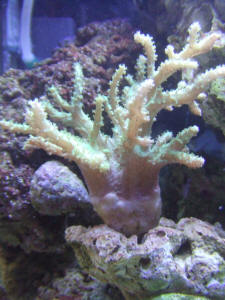 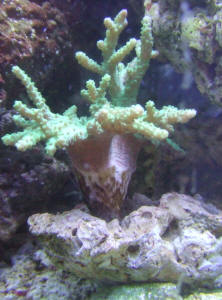 Dyed Dyed
|
|
Sinularia coral.. reading, data, lack of
6/25/10
<Hello Benita>
Hope you can help, bought this coral a week ago it has a white
stalk and yellow top, the polyps when they are out are short
flower shaped a bit like my toadstool, I was told it was a
Sinularia
<Could be, yes>
Problem been have since been told by a friend that it has been
dyed - would like your expert advice on what you think dyed or
not. if it is dyed can I save it or will it end up dying?
<Looks like, yes. Can recover with good care though, you make
no mention of any useful data. Read, search on WWM re: the care
of these quite easily kept animals http://www.wetwebmedia.com/alcyoniids.htm>
this is a pic 2nd day after buying it polyps were not out.
thank you for your help great site
Benita
<Simon>
|
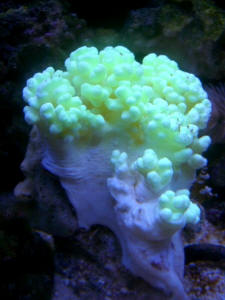 Dyed... and dying Dyed... and dying |
|
Coral confusion 4/16/10
Hello Bob,
<Richard>
My switch from the 55gal to the 65gal went well! I am extremely
happy with the results... and my inhabitants appear to share this
opinion. Some of the corals are opening/behaving in the fashion
that write-ups say they should.
Polyp extension at the appropriate times, improved color and form
- even the skimmer is operating at an improved efficiency! It has
been a very gratifying experience!
<Ah, good>
On to the issue. About three weeks ago, I purchased a frag that
was touted as an encrusting Montipora...
<Mmm, this looks like some sort of fading, dyed Fungiid... by
the skeletal gross morphology, striations, raised
areas...>
but the sales person was not too convincing. I have looked on the
web for images, and have not been able to confirm this claim. I
want to place it in the proper position/environment
<On the bottom...>
- as anyone should. I was wondering if you could give a
positive/proper ID on it please. Some images I have seen make me
think it is possibly an Acropora. Any thoughts? (Or am I way off
base?) Also, where could I link for proper information regarding
care and placement?
<I'd return this specimen... the colour is not natural...
summat is very wrong w/ its health>
I appreciate your assistance - with all the sources out there
(and the issue of questionable data), it appears that WWM is
perhaps the only source to got to in order to be steered in the
right direction!
Thanks again!
Richard J.C.
<Please read here: http://wetwebmedia.com/fungiidae.htm
and here: http://wetwebmedia.com/dyedcorals.htm
Bob Fenner>
|
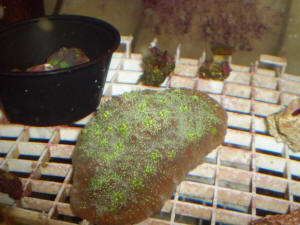 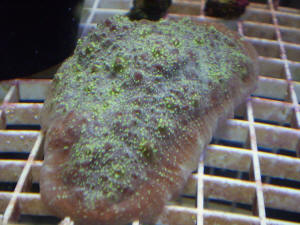
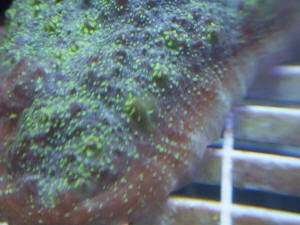 |
|
Coral ID 1/8/09 Hi Bob, <Hello
Beta. Minh at your service.> I have attached a pic of the
coral that I need an ID on. I don't much have info on the
specimen as the pic was sent to me by a friend. <I assume you
are referring to the brilliantly colored yellow encrusting hard
coral in the right center of the photograph, correct? At first
glance, one could pass this coral to be Porites sp. (perhaps
Porites cylindrica). However, upon closer inspection, the polyp
size and extension in comparison to the Turbinaria peltata on the
lower left indicates another coral from the genus Goniopora in
the Poritidae family. The size and extension of the polyps as
well as the growth form of this particular specimen resembles
Goniopora stutchburyi. However, the coloration of this specimen
does not appear to be natural and I'm afraid it could have
been dyed. Unfortunately, I have seen similar corals often
imported to our local fish stores in the states. More information
about dyed corals including a photo of a close matching specimen
can be found here:
http://www.reefkeeping.com/issues/2002-09/eb/index.php. Also,
more information about care of Goniopora stutchburyi can be found
in detail here:
http://www.advancedaquarist.com/2005/10/aafeature2/. I have been
researching Goniopora care for a few years now, so feel free to
write back with more information on identification or care of
this genus.> Regards Beta India <Good luck. Cheers, Minh
Huynh.>
|
 |
| Leather coral health, no useful info.
7/15/08 Hi guys, I am new to the hobby and have a good size
leather coral in my 140 gal tank. My leather is approx 6-8 inches
wide when fully open. He has always been rather healthy, but in the
past two days he seems to be not opening as wide as normal and
seems to changed colors a bit. He is normally a purple color with a
strawberry like texture to him, <? Really? I see a Lobophytum in
your photo... Have never encountered a member of this genus colored
such> but now he seems to have a marble look to him with a
darker color and white stripes. Any help would be good. Thank you!
<... no other data? Read here:
http://wetwebmedia.com/alcydisf12.htm and the linked files
above.... Need to know re set-up, foods/feeding, maintenance/water
quality tests, other livestock, recent activity... Bob
Fenner> |
|
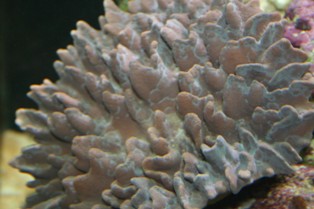 Was dyed. Was dyed.
|
Lobed Leather Coral Problem 7/12/08
Hello, <Greg> I recently purchased a rose colored <? Have never seen
such in the wild...> leather coral for a reef aquarium. Other
inhabitants at the time were an open brain coral, some platypoa (sp?) <Maybe
Palythoa> polyps, pipe organ, and a mushroom rock. Everything was going great
for weeks. All corals were healthy and opening fully, including the leather.? I
then added one other mushroom rock and a single large hairy mushroom. <Oh oh...>
The leather still had plenty of room to open and not be touched by any other
coral. I left for vacation a few days later and returned today. I have now
noticed some yellow spots on the rose leather coral, with one spot turning into
a yellow ring with darker tissue inside the ring. There is also a blotch of pale
yellow on one area of the coral. I am assuming this is some type of necrosis. Am
I dealing with some type of chemical warfare or may it be a water quality
problem. <Likely the first, perhaps some of the second> All other corals are
acting fine. Tank parameters are: pH: 8.4 Salinity: 1.024 Temp: 80 F Ammonia:?0
Nitrite: 0 Nitrate:?0 I did notice that there was a power failure while I was
gone, but I don't know for how long. Also, the pH seems to have been unusually
stable while I was gone.? Usually it drifts down to 8.1 - 8.2 over several days
and I buffer it back up to 8.3 - 8.4.? <Mmm, through water changes, gradually I
hope, trust> However, after leaving for a week, the pH stayed right at 8.4.?
This hasn't happen before.? I did change some activated carbon and cleaned out
the skimmer cup before leaving on vacation.? Should I leave it alone and see
what happens or take some action. Thanks, Greg <Read here:
http://wetwebmedia.com/cnidcompppt.htm and the linked files above. Bob Fenner>
Re: Lobed Leather Coral Problem
7/18/08 Greetings, <Salutations> Still having a problem
with a leather coral.? <You are??> It appears to be in the
process of shedding, but there are several spots of a yellow
dried wax like substance.? The yellow substance comes off easily
when rubbed with a dull plastic tip.? <Good... likely natural
material... exudate... thought to be useful in preventing fouling
organism establishment and more> No tissue necrosis
underneath, but the tissue color appears different than
surrounding tissue.? Coral has been closed up for about a week
now.? It is not showing any tissue degeneration, but does slough
off some mucous on different? spots every night.? Lastly, I have
notice some very small flat worm looking organisms on the coral
after lights out.? <Might be... flatworms> I siphoned them
off, but can't tell if any damage was done.? Some small
shrimp looking animals have also been seen after lights out
crawling around on the coral.? What should I do from here??
<Mmm, keep on, keeping on...> How long should it take for
the coral to shed?? <Usually hours to days...> Is a week
unlikely?? Two weeks? Thanks, Greg <Boosting health,
circulation, water quality... should help all the way around...
Read again where you were referred to. Bob Fenner>
| Mystery Coral... reading...
3/6/08 Dear Crew, I just purchased a coral from my LFS last
week. They said it was a green-eyed Goniopora, because that's
how it was labeled at the warehouse. <Mmm, does appear to be of
this genus... perhaps artificially dyed...> However, it looks
nothing like a Goniopora. <The pix are blurry, but do look at
the individual polyps, the corallites... and read here:
http://wetwebmedia.com/gonioporapix.htm> I have searched all
over the Internet and have been unable to find anything that
resembles it. The LFS said they'd take it back if it were
indeed a Goniopora sp. The coral has a hard skeleton and is LPS in
nature. <Please send along a better resolved, closer
image...> From the skeleton, very small fluorescent green polyps
(no more than 1 or 2 mm in diameter) extend no farther than a
couple of mm, under 65 watt compact fluorescent and 400 watt metal
halide lighting. I have the coral positioned away from the halide,
since I do not know how much light it needs and I do not want to
bleach it or stress it. The coral responded well to DT's
phytoplankton. <... see the above citations linked files
above... on Feeding...> The coral appears to be an encrusting
species. I have attached pictures. I hope they are clear enough for
you to see. I guess the glass and water in the aquarium diffracts
the light too much when I zoom in, because it always gets blurry.
<Is more likely limitation/s of the camera, lens...> Also,
around the base of the coral are some smooth, brown things. I
thought at first that they were a type of flat worm. but they
appear to be rather hard (firm may be a better word) and they do
not seem to be moving. Any thoughts? <Looks like inorganic
substrate/matrix...> You may be able to see them in the pics.
They seem to have three small dark dots that are slightly raised on
them. I removed one with a pair of tweezers. It had no noticeable
traits and it was firmly attached all the way to the base. Thank
y'all ahead of time for all that you do and your commitment to
the hobby. Thank you, Brolin Evans P.S. I want to thank Brenda and
let her know that my BTA is doing wonderfully after its incident
with the powerhead. It seems to have fully recovered. <Ah,
good... Read. Bob Fenner> |
|
 
|
Dyed coral -02/25/08 Crew, Thank you in
advance. On the way home from purchasing this coral today (picture
attached), it suddenly occurred to me that it is most likely dyed.
There is probably a reason I've never seen one this color.
<Indeed, this is an unnatural pink for a leather coral. Please
see here: http://www.wetwebmedia.com/dyedcorals.htm> I believe
it is some sort of leather as that is the feel it has. My question
is will it harm any of my other tank inhabitants? <The dye or
the leather? If the tank is a decent size (not a nano), the dye
probably won't harm anything else (but it's a good idea to
run some activated carbon anyway). However, leather corals in
general (dyed or not) can be toxic to stony corals.> I realize
it is probably doomed itself, but is that the extent of the threat?
Thank you, <No, it's not doomed. But as it recovers, the
pink color will fade. It's hard to say what color it will be
after the dye is gone, but hopefully it will survive and you'll
find out. :-)> Ben
<Best,
Sara M.> |
|
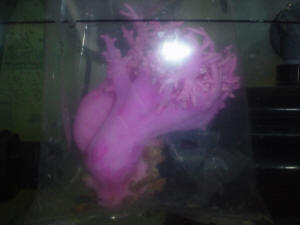 Yowzah, dat's peenk! RMF. Yowzah, dat's peenk! RMF.
|
Yellow Leather Coloring Issue -02/21/2008
Good Morning WWM Crew, I'm writing today to inquire more about a
coral vanity question rather than its health. <Not to get too
philosophical, but shouldn't these be more one in the same? How
"beautiful" could any unhealthy coral be?> I got the
most spectacular yellow Fiji leather a few months back. As you can
see in the picture attached it is sunshine yellow. (Forgive the
unhappiness of the coral, the picture was taken only moments after
introduction into my tank). <Please see here:
http://www.wetwebmedia.com/dyedcorals.htm> I have it situated
approximately 5? below the waterline under 4 54W T5 bulbs. (1
white, 2 Blue, 1 Purple). Over time it has gradually become more
brown in color towards the edges of the skin and the polyps.
<Hmmm, this tends to happen as dyed corals recover.> It is
growing nicely and extends its polyps daily, <awesome> but it
just isn't the same spectacular sight anymore. <Sure it is...
but it's spectacular in a different color now.> Is the
discoloration from lack of light or too much light? I've also
attached a picture of the whole tank so you can see that it is
placed far enough away from any other corals that might be causing
chemical warfare. <Well, as far as chemical warfare goes,
I'd worry more about the leather coral(s) hurting the stony
corals. Leather corals can be quite toxic to many stony corals.>
I'm interested to know your opinion and your recommendations for
how to get the old color back. (Please note these are old pictures
and do not accurately portray the color now) <The best advice I
can give you is to care for the coral as best you can and to maybe
be a bit more "flexible" in what you consider beautiful.
Or, if you really must have a bright yellow coral, try to find one
that's naturally that way (rather than artificially dyed that
color).> Sincere Regards,
Jessica L.
<Best,
Sara M.> |
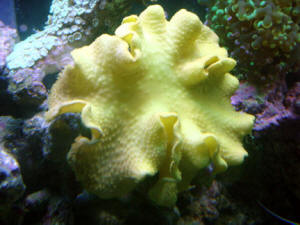 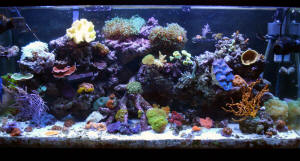 |
|
Sarcophyton elegans... or dyed? The latter.
RMF.
|
Artificially dyed Colt? Help!!
12/2/07 Hi WWM staff, For starters, I am a first time writer,
long time reader of your site, I think it's great and has
helped me a lot!!! Now, I bought this pink Colt on Friday, because
I thought it was so beautiful. However, the very next day (and only
by coincidence) I found your article on dyed corals, but the
pictures would not load. I am not aware of a colts range of color,
I know the article says they are often dyed the color of magenta,
but this one is pink. Can you please tell me if this one is dyed?
<Yes, unfortunately, it is very much dyed.> I have every
intentions of returning it if it is the case. <Good, and please
feel free, encouraged even, to chew out whoever did this (if you
know who). It's a cruel and senseless thing to do to a
coral.> Thank you for the help in advance and keep up the GREAT
work with the site. <Gracias and de nada>
Bernie
<Best,
Sara M.> |
|
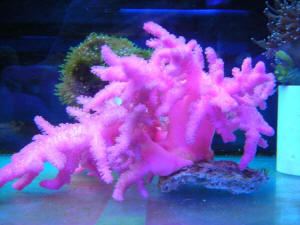
|
Dyed Torch Coral? - 11/08/07
Hi, <<Howdy>> Is there such a thing as a torch with light
purple tentacles with green tips? My LFS has one and said they see them
from time to time. Just wondering if they were dyed in your opinion?
Thanks, James <<I have seen this color morph (some are quite
spectacular) and I do believe it to be real. Their appearance in the
trade does seem to be spotty as eluded by your LFS; at least this is so
here on the East Coast...and they generally command a premium price, in
my experience. Regards, EricR>> <Interesting... RMF has never
encountered such a colored Euphyllia underwater... in thousands of
dives>
Dyed Leather Coral 9/23/07 Bob,
<Sorry, Sara here.> I need some help identifying this coral.
I've looked for any picture in the web that resembles it and I
can't find one. Is it a colt or maybe a leather? <Yes, it
looks like some kind of leather coral.> When I purchased it all
it said was that it's a soft coral. I am sending a couple of
pictures so that maybe you can identify it. <Leather corals are
difficult to ID, but it's definitely dyed. Which is unfortunate
since this is very bad for the coral. It should get better though
after it sheds.> <<Mmmm, maybe not. RMF>> Thanks
Elsa
<De nada,
Sara M.> |
|
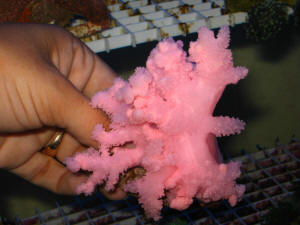 Ooooh, Lordy! Dat's peenk! Ooooh, Lordy! Dat's peenk!
|
Dyed Cup Coral? - 04/07/07 Hi
gang, <Hi Chuck.> My usually-very-good LFS just brought in two
VERY yellow cup corals. . . <Mmm...if Turbinaria peltata then it
almost certainly dyed, however it could be Turbinaria
reniformis which, unlike T. Peltata can exhibit such color. T. Peltata
however is unfortunately dyed yellow very often.> with color
hue/chroma/intensity very similar to that displayed by my healthy
yellow tang. <If it's that bright then I'd say the chances
of foul-play may be growing.> What makes me somewhat suspicious --
besides the relative intensity of the color -- is that that
'skeletal' portion also displays the uniform bright yellow
color, even with the polyps retracted. . . <Could be a recent...and
thorough dye job, if is in fact dyed.> whereas the picture of a
yellow I'd seen here on WWM seemed to indicate bright yellow polyps
on a close-to-brown skeleton. <Depends on the exact species...but if
dyed recently then the animal would be yellow all over.> Is it
likely these corals HAVEN'T been dyed? <Mmm it's not
possible to give you a 100% firm answer, but from what you have told me
I would assume it is dyed.> I'd love to think they were real. .
. <That's how "they" reel you in...> Chuck <Adam
J.>
Leather coral dropping branches 2/6/07 Hi there, <Hello> I
hope you can help me out here lately my pink
<Pink?... Not a natural color...> branching leather has been
dropping branches. I had a problem with this about 3 months ago.
<... The beginnings of sentences are capitalized...> when I
finally realized that I had him in an area of very low current it was
too late he had already dropped about 4 or 5 branches. after that I
moved him into the high current off my protein skimmer. ever since
he's been doing great, his polyps expand and he swells up and looks
beautiful. then last week he dropped another branch. I figured that it
was normal it seemed like that branch was sort of in the way of others.
but now today it looks like he's going to drop another and this one
is big! probably a sixth of his mass. Its starting to crimp which is
what happens before he drops one as I've seen. What do you think
might be the problem and is there anyway to save this branch?
<Can't tell with the dearth of information (not) offered... What
chem.?, Lighting? > The current is high, I have 65 watts daylight
(full spectrum) and 65 watt actinic; a little low but everyone's
seems to be fine and threes not much room on a 29 gal. <Too
small> the water quality is a close to perfect as it can get and I
feed phyto-plankton everyday. the only problem I can see is that the
temp is a bit low due to the winter months. it's about 76, 77
degrees but today I'm going to go buy a small heater to fix this.
any input would be great Thanks Shawn <Please read here: http://www.wetwebmedia.com/alcyonsysfaqs.htm and the linked
files above. Bob Fenner>
Dyed Kenya coral 12/31/06 Hi
<,> i <I> wondered if you thought that this was a dyed
coral? it <It> is being sold as an orchid kenya <Kenya>
tree. thanks <Thanks> for your help -Branden tucker
<Tucker> <Mmm, did you send a pic with this? Not here... Have
seen dyed Kenya Tree Corals... Bob Fenner>
Dyed Ricordea? -
06/20/06 Dear Crew, <<Evening Narayan>> I've read
about dyed soft corals, anemones and glass fish on WWM.
<<Indeed>> But just out of curiosity, have you heard of
anyone dying Ricordea? <<Can't say that I have>> The
reason I ask is that my LFS has a bright florescent-green polyp that
looks too bright and florescent to be real. <<Hmm...>> I
searched the Internet for pictures and haven't found one that
colorful. <<Perhaps a true "find"...or perhaps
not...>> I'm very tempted, but I want to make sure...
<<Is a possibility I suppose...I think you'll have to use
your own good judgment here>> Thank you, Narayan <<Welcome,
EricR>>
Re: Dyed Ricordea? -
06/21/06 Thanks! I'll let you know if it's offspring are
not as vibrant! Narayan <<Please do! EricR>>
Dyed finger leather? <Mmm, your pic didn't come
through... but yes, there are such things...> Well unfortunately I
saw your articles to late, and my vote went to one of the bad guys..
But even with my slow learning curve I will make sure this will never
happen again. <Good> My tank is a more or less a lagoonal set up
with moderate light and flow. After reading it sounds as if this
optimum conditions for my "starving" softy. But am I reading
correctly that I'm more or less doomed? <Need definitions... oh,
your Alcyoniid might yet recover, lose the artificial color...>
Because of the efficiency of food we can possibly provide? Could I
impose on you to first confirm what I have is dyed? Secondly, any
suggestion to keep this guy from becoming a sad
statistic? Thank you in advance for your time and
consideration. <Please do try sending along the pic as an attached
jpeg or bmp... Bob Fenner> Justin Bales
| Dyed Colt Coral...oh, yeah! The proof is in the skimmate
2/13/04 Crew, <cheers> I saw several Colt Corals
(Cladiella/Alcyonium) in a LFS last night and wonder about their
"authenticity". <no need to wonder... a
common and nefarious practice> They had beautiful rose to purple
color with relatively long branches. I've never seen a Colt
that color. <and never will in the sea <G>>
I inquired about their origin and was told that they came from some
island off Australia. The name was East T.... (sorry,
can't remember the exact name). <haha...hoohoo...hehee>
Anyway, the story was that they came from reefs that had not been
harvested for over ten years due to civil unrest in the
area. <haaaaaaaaaaaaaaaaaaaaaaaaaahahahahahahhahaha.
Oooooh. That's a good one> Some of the shipment had
deteriorated and the owner had placed them in a propagation tank to
see if he could salvage some cuttings. I noticed the
skimmer cup from that tank had pink tinted skimmate.
<oh, yeah> Is it possible that these corals are dyed or is
there a true rose/purple colored Colt? <nope... you
win the hairy kewpie doll. The coral was/is dyed. And the LFS in
this case passed on or created a naughty lie about the origin of it
I suspect. Natural corals do not "bleed" color as
evidenced by your keen eye on the skimmate. Kudos to you my
friend> Your insight would be appreciated. Regards, Barry <an
article here on the shameful practice: http://www.wetwebmedia.com/dyedcorals.htm
<..... civil unrest off the coast of Australia preventing purple
colt collections. Heehee... I loved that one <G>. Thanks for
sharing :) Anthony. |
| Article Q&A, collection practices in Indo. Hi
<Hello> You have a question from a user titled: Dyed Colt
Coral...oh, yeah! The proof is in the skimmate 2/13/04 http://www.wetwebmedia.com/dyedcoralfaqs.htm
You just might want to make a note of the place he is talking about
in reference to the location of the dyed coral is: East Timor.
Close to Australia but not part of Australia. <No>
There's a lot of very bad collection practices in Indonesian
waters and on principle many people from Australia wont buy from
Asia Pacific. Cheers Leanne <Thank you for this. Will try to
find this piece and post your note alongside it. Bob
Fenner> |
Dyed Colt Coral...oh, yeah! II 2/13/04
Anthony, <cheers, my friend> Thanks. Although I was
pretty confident of my assessment, I wanted to get your expert opinion.
<understood and agreed... there certainly are many naturally
occurring colors every bit as pretty as this dyed specimen in the sea.
As such, your hope that it was real and good sense to check before
buying were all quite natural and warranted> Actually, I think the
young owner and his "start-up" business were duped by a
supplier. <it is often the case... do feel welcome to
share that article of mine with him if this shop own is open minded. It
would be great to win over and help to shape a conscientious merchant.
I wish him/her the very best if they are so inclined to learn and grow.
Profits can be made by being a responsible retailer> I enjoyed the
"off the coast of Australia" story too and, in fact, that was
as much a giveaway to me as the color. Thanks for the link -
that's it - they're MAGENTA! exactly as in the picture in your
article. I will inform the owner and the membership of my
Reef Club re: these corals. <excellent my friend... and be sure to
do so politely. Much better to educate than offend a LFS :) > Also
"In shared admiration of the sea" Barry <ah,
yes! Thank you Barry. Kindly, Anthony>
Dyed yellow Turbinaria 2/26/03 Greetings
to the crew. Your site has helped me so much I can never
repay you enough except to say that my 55g reef is doing well now and
will buy all your books (not a plug) in the future. <thanks kindly
<G>> I did make the mistake of purchasing a yellow Turbinaria
p. From your site I now know this animal has probably been
dyed. <not too bad... it is on of the few corals that
can survive dying because you can feed it (and must)> The LFS of
course told me it was a rare specimen and at 25% off I would kick
myself if I didn't buy it. <wow... that clerk was a real
scumbag> Now I am kicking myself right in the.... Anyway the
specimen looks mostly a pale brown color except for the extended polyps
that are bright yellow. My question; the polyps extend every day and
they seem to be accepting food <excellent! that's most of the
battle> (I use a blender to mix krill and phytoplankton then turkey
baste). I noticed today a small, about 1/2' round area
on the very edge of the animal that is turning red. <I
have seen some specimens issue a red/burgundy growth edge instead of a
doughy pale colored one> Any thoughts on what this might be and what
measures I should take? <if the tissue doe not look necrotic, it may
be natural. Do send a picture if you can> There are no other
bothersome fish or animals in the tank. Water checks out
great, skimmate daily, some iodine and calcium added
weekly. PH 8.4, calc 475, sg 1.024, etc.... Any help would
be appreciated. <keep strong turbulent (not linear) water flow over
this specimen too for optimal polyp extension. Anthony>
Red Lobophytum Hi: <<Hello, JasonC
here...>> I bought a red leather coral @ a local pet store. I
tried to find the genus on the web and found that it is a Lobophytum
sp. The problem is the color. I could find no information that says
that it comes in red. I did find a picture of one that looks just like
mine but it is green. The one I have is BRIGHT pink. I'm wondering
if this Lobophytum could be dyed. <<Does sound like it...>>
Although it has been 3 weeks it has not faded but the liquid in the
protein skimmer IS red. <<Interesting, certainly a good
indicator.>> If it is dyed how long will the color last?
<<Not more than a couple of months.>> Lastly will the dye
harm anything else? <<I doubt it, and it sounds like your skimmer
will grab it out so... no worries.>> Thanks Steve <<Cheers,
J -- >>
Another dyed coral pic Anthony,
here's a couple of shots of a very green Heliofungia I saw at
yesterdays.... WWPSA tradeshow (!) in Anaheim. Have placed one on the
FAQs file alongside your article on WWM. Bob F
Re: Another dyed coral pic Bobster...
thank you for the pic post. It reminds me that I haven't done
anything with that article. I though FAMA would be one of the few mag.s
that might publish it. <They will Anthony... and I'd send it for
sure to German, Italian, French and Japanese magazines... Yes, I do the
same with worthwhile pieces like this expose> Can you think of
another Mag that might give it a shot? <Mmm, next choice would be
AFM... worth trying... they're no slower to print, pay better...
but FAMA will give you and hobbyists the largest exposure, and
impact...> I figured the soapbox tone and the fact that enough shops
carry the dyed corals would make it untouchable for mainstream rags?
<Not at all> I hadn't heard of any Fungiids being
dyed...sheesh! Did it look very unnatural? <No... I could see it
"glowing like radium" from across the hall...> The
optimist in me says remember the natural green Fungia from Bali, and
the lovely green helmets (Cycloseris) from the Solomons... But, that
Helio is REALLY green!!! <Really, REALLY green, believe me. I
thought, hoped this was just a replica... as some of Walt's new
product was on display in a tank in the same vendor's booth... but
it was... alive... for the while> Gonna go find a beer to cry into
:) <I'd join you, maybe I will any way, in abstentia. Bob
F>
- Is this Coral Dying - Hey WWM, Thanks for the
information on the last e-mail, you guys are the best.
A few months ago, I bought a Yellow Fiji Leather Coral (What I was
told), and now after a few months, it is not so yellow. The
"fingers" started turning brown to this color. The LFS
said that corals change color, and I was curious as to whether this
species changes color so dramatically. <Not in my
experience.><<Dyed specimen. RMF>> I looked on the FAQ's and must have missed
something. Any comments/feedback is greatly
appreciated. This had wonderful vibrant color that is disappearing.
Overall, the health of the coral appears to be fine, is it just a
color change? Or is something worse slowly happening? <I'm
sad to say that it may be something worse. The brown color is
typically caused by the Zooxanthellae that reside in the coral.
When corals turn white (which is the way it looks from this picture
- hard to tell with that fish in the way) it often means they are
expelling their Zooxanthellae which means they will soon die. Could
be a temperature issue in your tank - this is the most common
reason for bleaching, although not the only one. Would suggest you
read through the FAQs again, use the Google search and look up
bleaching.> Thanks Guys,
Chris
<Cheers, J -- > |
 |
Dyed Corals article Antoine (and Steve),
please find my marked-up copy of your piece here:
http://www.wetwebmedia.com/dyedcorals.htm Pls note my suggested changes
(marked as bold AND italicized words). I have simply added a word or
two or changed number... not meaning as I agree with the thesis here,
and its fervor of argument. You are welcome to utilize the dyed anemone
pic sent on (I have others if you'd like), and to adopt these
changes or modify the piece back to its original form. Bob F
Re: Turbinaria species, Dyed coral
Anthony...How can I better tell if this is a dyed animal? <a
matter of experience/information... size/shape of corallites and polyp
structures on the corallum indicate that this animal is almost
certainly T. peltata. It really cannot be anything else. Color has
nothing to do with coral identification. T. peltata for that matter
occurs in brown, green, teal, pink/tan, etc. Unfortunately yellow is
not a naturally occurring color for this species. Furthermore, T.
peltata is categorically in the top three commonly dyed coral. A truly
abhorrent practice as I'm sure you'd agree. An insult to the
magnificent beauty of the coral reef in all of its natural forms.
Reports indicate that this animal for its hardiness may survive the dye
job although not without some stress. Occasional feeding of very fine
food will be especially helpful to compensate for the reduced symbiotic
activity of the now masked (dyed/pigmented) tissue for
Zooxanthellae> All areas of the coral that are flesh covered
are the same shade of yellow. There is an area near the base stem that
are not flesh covered and it is pure white. If this is in fact a dyed
animal, what type of success do you predict (i.e. is there any chance)?
In the future, how can I avoid the purchase of a dyed coral. <just
research a species before you buy it. Know its needs, hardiness,
natural behavior (and colors<G>). Also read about current trends
in the industry... many threads about dyed corals on the big forums and
message boards. Membership in a good local aquarium society as well
will keep you informed> Regarding the Sebae, I have it under 275w PC
lighting. 3X55 10k/actinic, 1x55 6400k, 1x55 actinic. I change my bulbs
app. each 12 months...not all at once, but about 1 every month or so
until they are fresh. <excellent technique with the bulbs!
Kudos> I feed the anemone about once per week, usually squid,
octopus, or shrimp. Also, I have "blender mush" that I feed
the tank and usually the tomato clown gives a chunk to the
anemone. <also excellent> When I bought the anemone it was
pure white with purple tips. A few days later it expelled more
zoo(sp?)anthe and proceeded to let go of the rock it was on and roll
around the tank. <yes... sadly typical> I moved it to a
preferred (by me) position under the lights, and it grabbed on, only
moving about 8" to the place where it has been for last 22 months
or so. It has since turned brown, but has grown in size from 3"
across to now more than 14". <excellent... a success story.
Thank you for sharing it. FAQ readers take heed> I change about 15g
per month in this 50g system. I rarely use carbon at all, but I do get
a lot of skimmate from my Bak-Pak skimmer. <yes.... critical
for exporting dissolved organics especially with your lack of carbon
and average water changes schedule> My water is usually crystal
clear, but I use tap water so I get some diatom algae. <not a
crime> For current, I have the Rio 600 on the skimmer, AquaClear 802
ph, AquaClear 301 ph, and Catalina 100 PH. They are all on different
flow paths so the current is pretty random. <wow... fantastic!
over 1000pgh total circulation in this 50 gall but strategically random
turbulent. Highly effective and to be recommended. Keeps detritus in
suspension for a good skimmer, feeds corals more, etc> Also, I have
my LR elevated above the DSB with the Catalina PH blowing directly
under the LR structure. I maintain my Ph at 8.4, Alk at 14dKh, CA at
350-400ppm. I don't have any measurable NO2 or Ammonia, but my NO3
is usually about 5-10 ppm. I supplement with Kent SuperBuffer,
strontium/molybdenum, Zo? and some other that I can't remember.
<sounds very fine> Other corals in the system are: Hammer, Brain,
Frogspawn, bubble, Candycane, lots of colts, Sarcophyton, Sinularia,
green star polyps, hairy 'Shrooms, other misc. 'Shrooms, and
fox coral. I'm thinking of adding a pink Fungia and maybe a couple
of brightly colored sponges. Attached is a pic of the system taken in
April...it looks a little different now. <again... thank you for
sharing. Best regards, Anthony>
|
|

